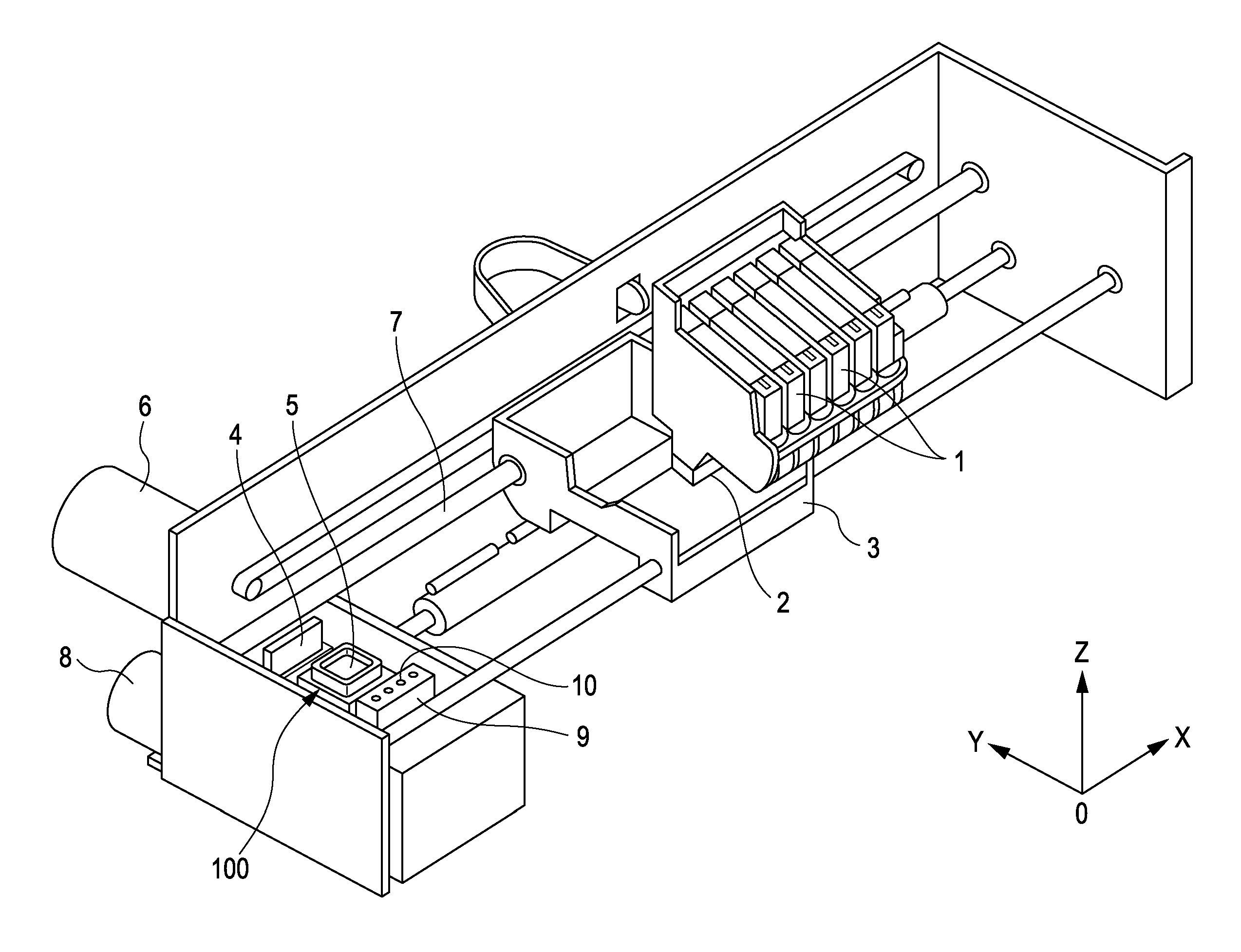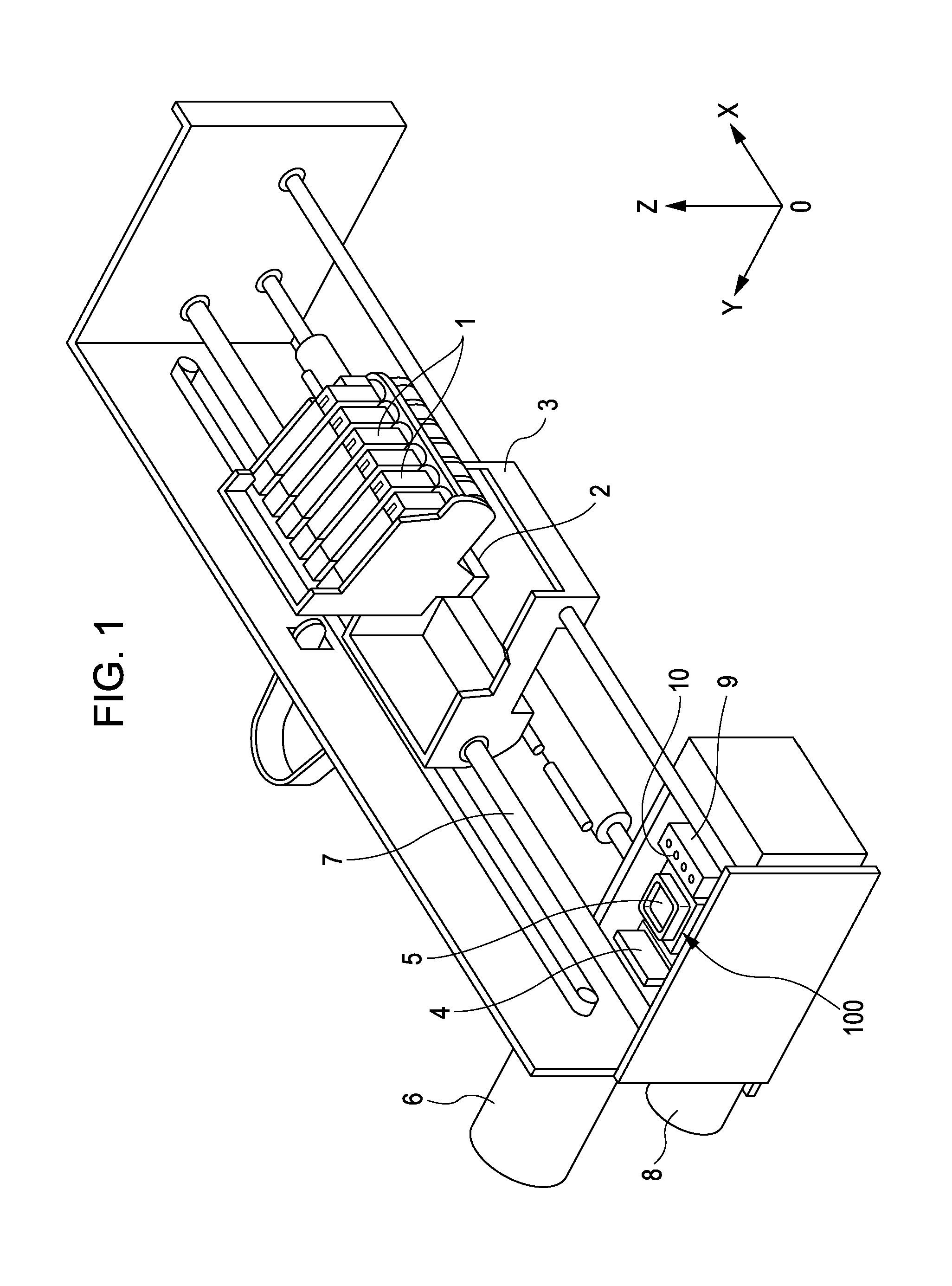Wiping method for inkjet recording head
a technology of inkjet recording head and wiping method, which is applied in printing and other directions, can solve the problems of large amount of processing liquid consumed, ink consumption increases, and failure of discharge, and achieve the effect of efficient wiping
- Summary
- Abstract
- Description
- Claims
- Application Information
AI Technical Summary
Benefits of technology
Problems solved by technology
Method used
Image
Examples
first embodiment
[0049]FIG. 1 is a perspective view of an inkjet recording apparatus according to a first embodiment. Referring to FIG. 1, an inkjet recording head 1 has a discharge-port surface 2 in which a plurality of discharge-port rows are formed in a predetermined pattern. The inkjet recording head 1 is mounted on a carriage 3. The carriage 3, on which the inkjet recording head 1 is mounted, is reciprocated in the X direction by a carriage motor 6 (main scanning). The carriage 3 that reciprocates is supported and guided by a guide shaft 7. A recovery unit 100 for maintaining and recovering the ink discharge performance of the inkjet recording head 1 is disposed within a movable range of the carriage 3 at a position outside a recording area.
[0050]The recovery unit 100 includes a wiper 4 for wiping the discharge-port surface 2 of the inkjet recording head 1, a cap 5 that can be tightly attached to the discharge-port surface 2 so as to cover the discharge-port rows, and a recovery-unit motor 8 fo...
second embodiment
[0057]FIGS. 4A to 4F are diagrams illustrating the movement of a wiper 4 according to a second embodiment. In the present embodiment, different from the first embodiment in which the processing liquid is directly applied to the discharge-port surface 2, first, the processing liquid is applied to the wiper 4. Then, the wiping process is performed by bringing the wiper 4 to which the processing liquid is applied into contact with the discharge-port surface 2. FIGS. 4A to 4F are sectional views of FIG. 1 taken along the YZ plane. An inkjet recording apparatus according to the present embodiment is similar to the inkjet recording apparatus shown in FIG. 1 except the processing-liquid ejecting unit 9 is replaced by a processing-liquid transferring unit 22. The processing-liquid transferring unit 22 also functions as the processing-liquid applying unit. A recording head 1 of the present embodiment is similar to the recording head according to the first embodiment shown in FIG. 3. FIG. 4A ...
third embodiment
[0063]FIG. 9 is a perspective view of a wiper 4 according to the third embodiment. Referring to FIG. 9, similar to the second embodiment, the wiper 4 according to the present embodiment has slits 25 that divide a portion of the wiper 4 that comes into contact with the discharge-port surface 2 into six segments corresponding to the discharge-port rows 14 to 19. Thus, the slits 25 serve to define wiper segments 26 to 31 in the wiper 4. More specifically, a wiper segment D 26 corresponding to the discharge-port row D 14, a wiper segment E 27 corresponding to the discharge-port row E 15, a wiper segment F 28 corresponding to the discharge-port row F 16, a wiper segment G 29 corresponding to the discharge-port row G 17, a wiper segment H 30 corresponding to the discharge-port row H 18, and a wiper segment J 31 corresponding to the discharge-port row J 19 are provided. An inkjet recording apparatus according to the present embodiment is similar to the inkjet recording apparatus shown in F...
PUM
 Login to View More
Login to View More Abstract
Description
Claims
Application Information
 Login to View More
Login to View More - R&D
- Intellectual Property
- Life Sciences
- Materials
- Tech Scout
- Unparalleled Data Quality
- Higher Quality Content
- 60% Fewer Hallucinations
Browse by: Latest US Patents, China's latest patents, Technical Efficacy Thesaurus, Application Domain, Technology Topic, Popular Technical Reports.
© 2025 PatSnap. All rights reserved.Legal|Privacy policy|Modern Slavery Act Transparency Statement|Sitemap|About US| Contact US: help@patsnap.com



